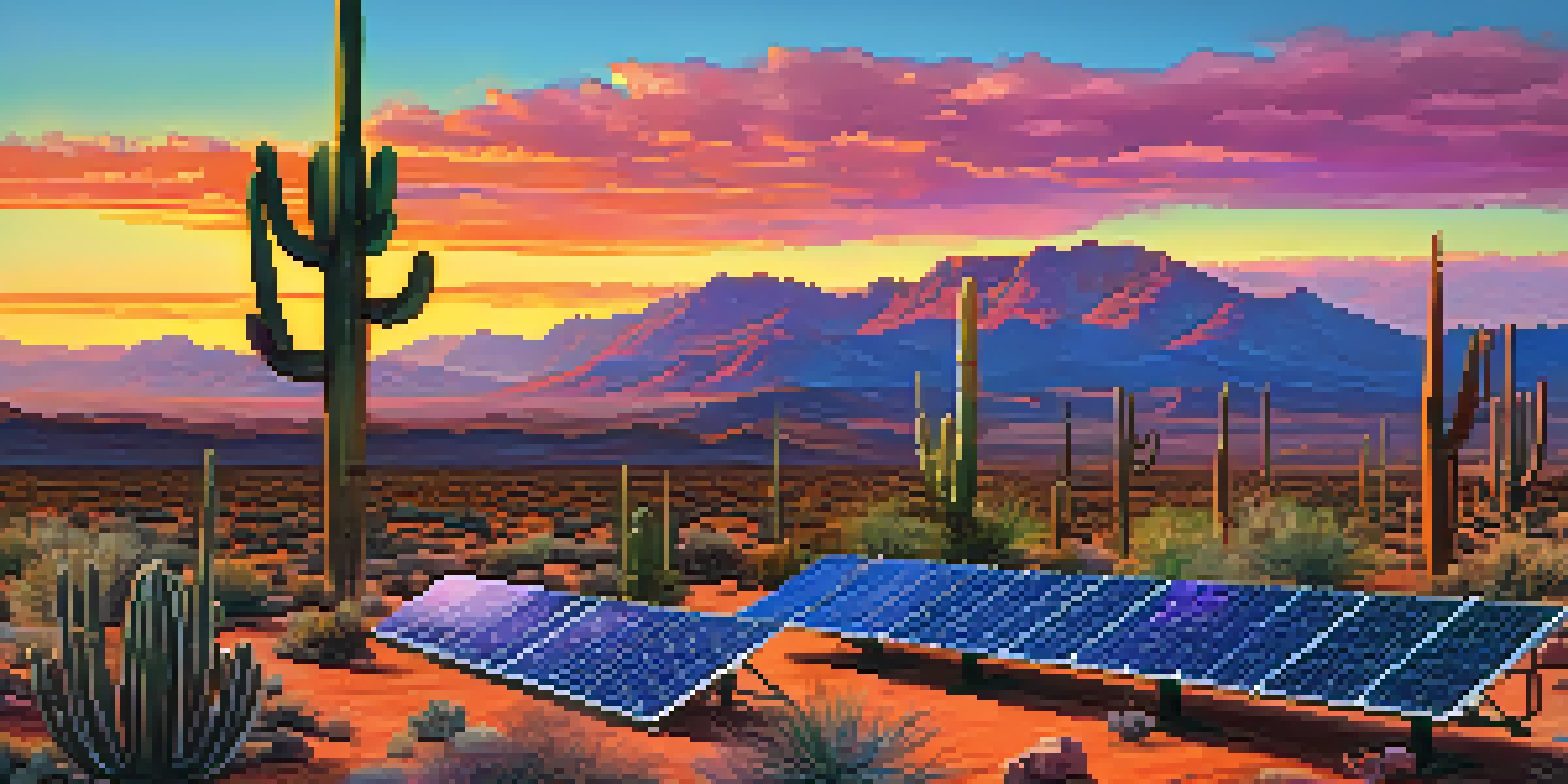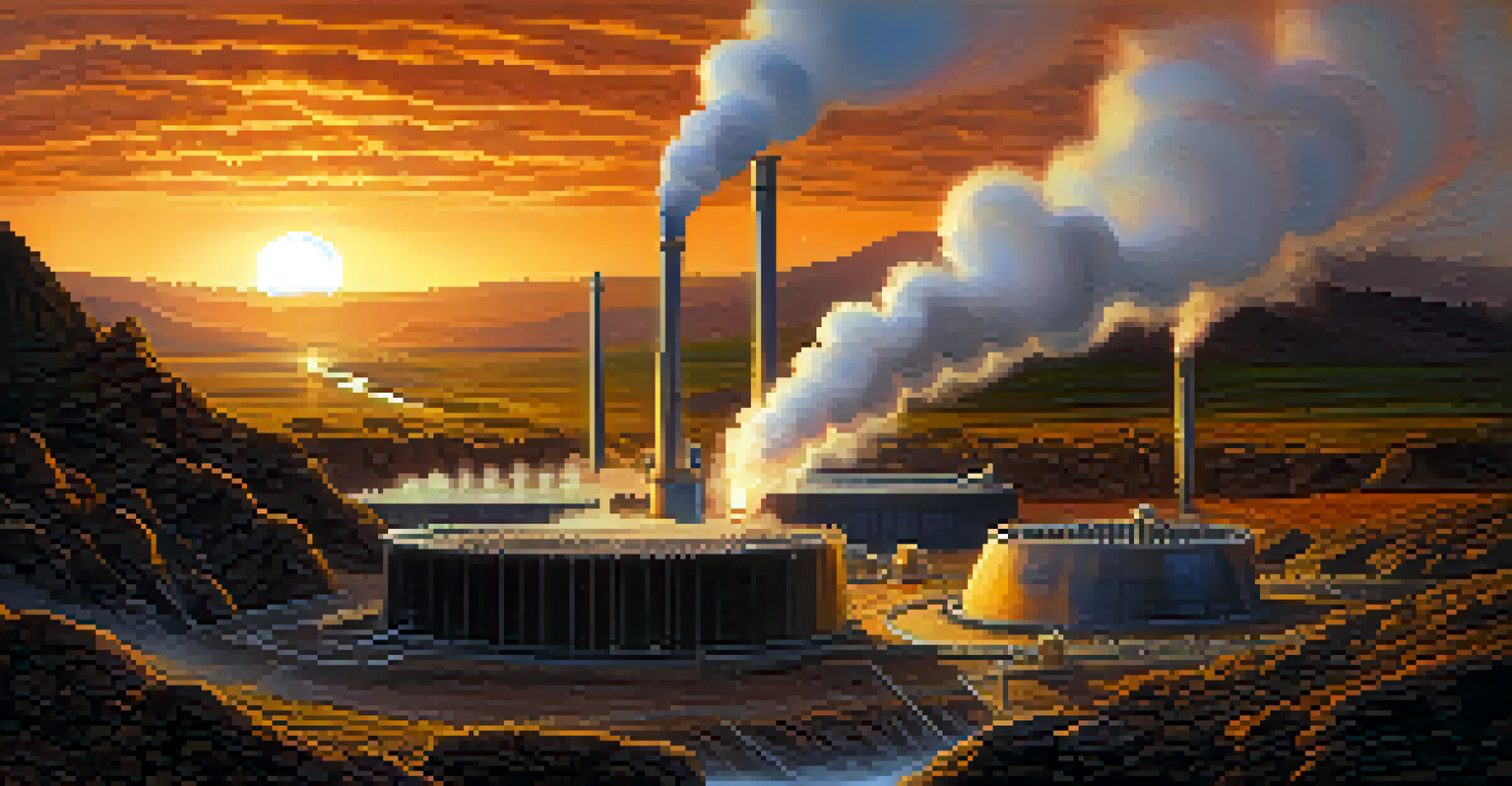Renewable Energy in Arizona: Opportunities and Challenges

Overview of Arizona's Renewable Energy Landscape
Arizona is a state rich in sunlight, making it a prime candidate for solar energy. With over 300 sunny days a year, the potential for harnessing solar power is immense. The state has made significant strides in renewable energy, contributing to both local economies and the fight against climate change.
The sun is the primary source of energy for the Earth and a key driver of our climate. Harnessing solar energy can help us mitigate climate change and reduce our reliance on fossil fuels.
In addition to solar, Arizona is exploring wind, geothermal, and biomass energy sources. Each of these renewable options presents unique benefits, from the consistency of wind in certain regions to the geothermal potential near volcanic areas. However, the state’s focus has predominantly been on solar due to its abundant sunlight.
Despite its potential, Arizona's renewable energy sector faces various challenges. Regulatory hurdles and competition from traditional fossil fuels often hinder growth, making it essential to navigate these complexities to fully leverage renewable resources.
The Solar Boom: A Closer Look
Solar energy has become the shining star of Arizona's renewable portfolio. Homeowners and businesses alike are increasingly investing in solar panels, attracted by the prospect of lower energy bills and tax incentives. In fact, Arizona ranks among the top states for installed solar capacity in the U.S.

Utility-scale solar projects have also gained traction, with several large solar farms contributing significantly to the state's energy mix. These projects not only generate clean energy but also create jobs and stimulate local economies. As technology advances, the cost of solar installations continues to drop, making it more accessible to everyone.
Solar Energy Dominates Arizona's Future
With abundant sunlight and growing investments, solar energy is the leading renewable resource in Arizona, promising lower energy costs and job creation.
However, the rapid growth of solar energy has sparked debates about grid management and energy storage. As more solar power flows into the grid, balancing supply and demand becomes crucial, highlighting the need for innovations in energy storage solutions.
Wind Energy: Untapped Potential
While solar energy steals the spotlight, wind energy remains an underutilized resource in Arizona. The state has areas, particularly in the northern region, that experience strong and consistent winds ideal for wind turbines. Harnessing this potential could diversify Arizona's energy sources and improve energy resilience.
Sustainable energy is a necessity, not a luxury. It is essential for our economic growth, energy security, and environmental sustainability.
Despite its advantages, wind energy development faces challenges such as limited infrastructure and community opposition. Local stakeholders often express concerns about the aesthetic impact of wind farms and potential effects on wildlife. Addressing these issues is vital for the future of wind energy in Arizona.
Nevertheless, advancements in turbine technology and growing public awareness about renewable energy could spur interest in wind projects. By promoting the benefits of wind energy, Arizona can tap into this valuable resource to complement its solar initiatives.
Geothermal Energy: A Hidden Gem
Geothermal energy, although lesser-known, holds significant promise for Arizona. The state's geological features provide opportunities for tapping into the Earth's heat, particularly in the northern regions. This renewable source offers a consistent and reliable energy supply, unlike solar and wind, which can be intermittent.
Currently, the development of geothermal energy in Arizona is still in its infancy. Challenges like high initial costs and technical expertise can deter investment, but the potential benefits are substantial. With further exploration and investment, geothermal energy could play a pivotal role in the state's energy future.
Wind and Geothermal: Untapped Resources
Despite their potential, wind and geothermal energy remain underutilized in Arizona, facing challenges like infrastructure limitations and high initial costs.
Educating stakeholders about the advantages of geothermal energy is essential for fostering growth. As awareness increases and technology improves, Arizona may well find itself at the forefront of geothermal energy development.
Biomass Energy: Local Solutions for Sustainability
Biomass energy, derived from organic materials, presents a unique opportunity for Arizona to enhance sustainability. Utilizing agricultural waste, wood products, and even municipal waste, biomass can provide a renewable energy source while addressing waste management issues. This dual benefit makes biomass an attractive option for local communities.
Several biomass projects in Arizona have demonstrated that converting waste to energy can be both environmentally and economically beneficial. By harnessing local resources, these projects create jobs and stimulate rural economies. Moreover, they can lead to reduced landfill waste and greenhouse gas emissions.
However, challenges such as supply chain logistics and competition with other energy sources can hinder biomass development. Building partnerships and community awareness will be critical to overcoming these hurdles and maximizing the potential of biomass energy.
Regulatory Challenges Facing Renewable Energy
Despite its potential, Arizona's renewable energy sector faces a maze of regulatory challenges. Policies governing energy generation and distribution can be complex, creating uncertainty for investors and developers. Navigating this landscape requires a clear understanding of local laws and regulations.
Recent legislative changes have both hindered and helped the growth of renewable energy. While some policies support clean energy initiatives, others may favor traditional fossil fuels, complicating the transition to renewables. Balancing these interests is crucial for fostering a sustainable energy future in Arizona.
Regulatory Hurdles Threaten Growth
Arizona's renewable energy sector struggles with complex regulations and competition from fossil fuels, making supportive policies essential for sustainable development.
Engaging in dialogue with policymakers and stakeholders is essential. By advocating for supportive regulations, the renewable energy sector can gain the momentum needed to thrive in the state.
Community Engagement: Key to Success
Community buy-in is critical for the success of renewable energy projects in Arizona. Local residents often have concerns about new developments, from environmental impacts to property values. Engaging with communities early in the planning process can help address these issues and build trust.
Education plays a vital role in fostering community support for renewable energy. By informing residents about the benefits of clean energy—such as job creation, lower energy costs, and environmental protection—developers can create a more favorable atmosphere for project approval.

Moreover, involving communities in renewable energy initiatives can lead to innovative solutions tailored to local needs. When residents feel a sense of ownership, they are more likely to support and participate in sustainability efforts, paving the way for a brighter energy future in Arizona.
The Future of Renewable Energy in Arizona
Looking ahead, the future of renewable energy in Arizona is bright, albeit challenging. With abundant natural resources and growing technological advancements, the state is well-positioned to become a leader in clean energy. However, addressing the existing barriers will be essential for realizing this potential.
Collaborations between government, industry, and communities can pave the way for innovative solutions and investments in renewable energy. By fostering an inclusive environment, Arizona can harness its diverse energy resources, ensuring a balanced and sustainable energy mix.
Ultimately, the journey toward a renewable energy future requires commitment and collaboration from all stakeholders. As Arizona embraces this transition, it can set an example for other states striving for a cleaner, more sustainable tomorrow.